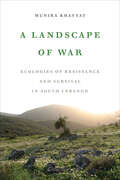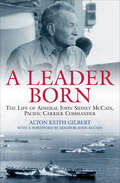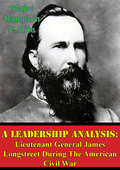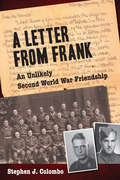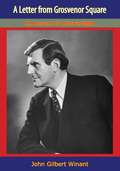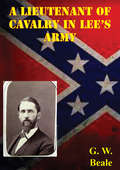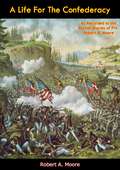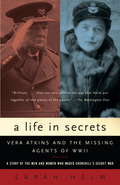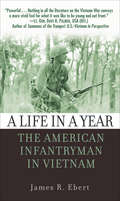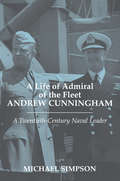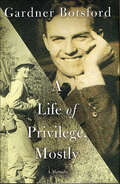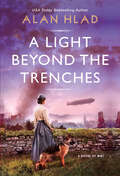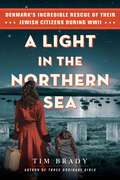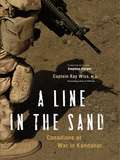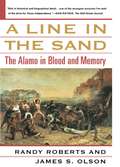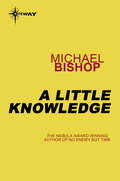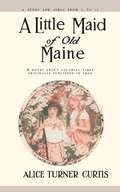- Table View
- List View
A Landscape of War: Ecologies of Resistance and Survival in South Lebanon
by Munira KhayyatWhat worlds take root in war? In this book, anthropologist Munira Khayyat describes life along the southern border of Lebanon, where resistant ecologies thrive amid a terrain of perennial war. A Landscape of War takes us to frontline villages where armed invasions, indiscriminate bombings, and scattered land mines have become the environment where everyday life is waged. This book dwells with multispecies partnerships such as tobacco farming and goatherding that carry life through seasons of destruction. Neither green-tinged utopia nor total devastation, these ecologies make life possible in an insistently deadly region. Sourcing an anthropology of war from where it is lived, this book decolonizes distant theories of war and brings to light creative practices forged in the midst of ongoing devastation. In lyrical prose that resonates with imperiled conditions across the Global South, Khayyat paints a portrait of war as a place where life must go on.
A Lawless Place: A Contraband Shore Novel (The Contraband Shore)
by David DonachieThe second volume in The Contraband Shore trilogy.1787: Captain Edward Brazier is devastated to find Betsey, the woman he wants to marry, imprisoned in her own home by her brother, Henry Tulkington, and trapped in an illegal marriage. With Brazier suspected of acting as a spy for a prime minister seeking to halt smuggling activity on the coast and still posing a threat to Betsey&’s increasingly deranged brother, he is walking a dangerously fine line.But Tulkington&’s arrogance is making him enemies, even in his own family, and his actions are becoming increasingly violent towards everyone who thinks to defy him. Brazier's only option is to join with the darker denizens of Deal in the hope of constructing an alliance which will see his lady freed.
A Leader Born: The Life of Admiral John Sidney McCain, Pacific Carrier Commander
by Alton Keith GilbertThis biography of one of World War II’s great military leaders is a “rich tribute to a staunch American naval hero” (WWII Quarterly).John S. “Slew” McCain was an old-school sailor. Wiry, profane, a cusser, and a gambler, he reminded more than one observer of Popeye. He was also a pioneer in the hard-hitting naval tactics that brought Imperial Japan to its knees.McCain graduated from Annapolis in 1906 and served aboard an armored cruiser in World War I. Perceiving the future of naval warfare, he earned his aviation wings in 1936, and by 1939, McCain was commander of the aircraft carrier USS Ranger. He was thus well-placed to play a leading role in America’s cut-and-thrust war with the Japanese across the broad expanses of the Pacific. In 1942, he was made commander of all land-based aircraft during the campaign for Guadalcanal. Though he took his share of blame for the disaster at Savo Island, he counterattacked with every means at his disposal, to the point of commandeering the planes of the crippled carriers Enterprise and Saratoga to reinforce US strength on Henderson Field.By the time the US returned to the Philippines, McCain was leading a fast carrier task force under William “Bull” Halsey. When asked what he thought about his carrier commander, Halsey replied, “Not much more than my right arm.” McCain’s carrier group would destroy thousands of enemy planes and hundreds of ships with aggressive swarming tactics. Four days after Japan officially surrendered, McCain died in his bed. His name has lived on, however, through his son, who became commander of US naval forces in the Pacific, and his grandson, John S. McCain III, carrier pilot, Vietnam POW, and United States Senator.Drawing upon a wealth of primary sources, including information provided by the McCain family, as well as an expert grasp of the titanic battles waged by the US armed forces in the Pacific, Alton Keith Gilbert has provided the fullest account of the Admiral John McCain’s life yet written.
A Leadership Analysis: Lieutenant General James Longstreet During The American Civil War
by Major Hampton E. HiteThis thesis is a chronological analysis of Longstreet during the thirteen major campaigns in which he participated: First Manassas, Williamsburg, Seven Pines, the Seven Days, Second Manassas, Antietam, Fredericksburg, Suffolk, Gettysburg, Chickamauga, Knoxville, the Wilderness, and Petersburg. The primary thesis question is: Was Longstreet's leadership during the war satisfactory when analyzed in the context of the nine leadership competencies of FM 22-100, Military Leadership?The nine leadership competencies are the result of a 1976 study group consisting of army leaders ranking from Corporal to General. The nine competencies are: supervision, soldier/team development, technical and tactical proficiency, use of available systems, professional ethics, planning, decision making, teaching and counseling, and communications.After a discussion of each campaign an analysis of Longstreet's leadership is conducted using the leadership competencies as analytical criteria. A leadership profile of Longstreet evolves as he gains experience during the war and is assigned to positions of increased responsibility.The conclusion of this thesis is that Longstreet's leadership was satisfactory during the war when analyzed in the context of the nine leadership competencies. Over the course of the thirteen campaigns mentioned above, Longstreet's leadership was satisfactory or better in a clear majority of the nine leadership competencies.The purpose of this study is to add to the Longstreet debate in a unique way. Longstreet is analyzed using nine doctrinally accepted leadership competencies to provide a constant measurement tool throughout the thesis. This should eliminate some of the emotion from the Longstreet debate.
A Leaf on the Wind of All Hallows: An Outlander Novella (Outlander)
by Diana GabaldonIn this original Outlander novella, Diana Gabaldon reveals what really happened to Roger MacKenzie Wakefield's parents. Orphaned during World War II, Roger believed that his mother died during the London Blitz, and that his father, an RAF pilot, was killed in combat. But in An Echo in the Bone, Roger discovers that this may not be the whole story. Now, in "A Leaf on the Wind of All Hallows," readers learn the truth. Praise for Diana Gabaldon's Outlander series "All you've come to expect from Gabaldon . . . adventure, history, romance, fantasy."--The Arizona Republic, on An Echo in the Bone "A grand adventure written on a canvas that probes the heart, weighs the soul and measures the human spirit across ten generations."--CNN, on The Fiery Cross "Escapist historical fiction at its best."--San Antonio Express-News, on Drums of Autumn "A feast for ravenous readers of eighteenth-century Scottish history, heroism and romance."--Kirkus Reviews, on Outlander
A Letter from Frank: The Second World War Through the Eyes of a Canadian Soldier and a German Paratrooper
by Stephen J. ColomboOn the last day of the Second World War, Frank and Russ fought each other. In the days after, they became friends. This is the remarkable tale of a long-forgotten letter. It was written from Germany in the aftermath of the Second World War to a Canadian in a peaceful Southern Ontario town. Both had been soldiers and had met on a German battlefield. The letter lay unseen for years and was found by the Canadian’s son long after the old soldier’s death. This book tells how that faded letter led to the discovery of the one-time German paratrooper who became his father’s friend in the immediate aftermath of the war. A Letter from Frank is part war story and part biography, following the lives of Russ Colombo, the Canadian soldier, and Frank Sikora, the German paratrooper. One grew up during the Depression in Ontario, the other was a German in Nazi-occupied Czechoslovakia. This non-fiction narrative also chronicles author Stephen J. Colombo’s struggle to come to terms with a father haunted by the war. Their recollections provide insights into the events that shaped the generations that forged a modern Canada and rebuilt Germany after its near-total devastation. In a surprising twist, this book also provides previously unknown historical details of later NHL president Clarence Campbell at war (Campbell was Russ Colombo’s commanding officer).
A Letter from Grosvenor Square: An Account of a Stewardship
by John Gilbert WinantIn England’s darkest hours, John Winant, U.S. Ambassador, became to the British a symbol of American fellowship and support. They looked up from the still-smoking rubble of their homes and saw him standing strong with the King or with Winston Churchill.As Ambassador, his chief concern was not only immediate agreement and understanding between the two countries, but also long-term good relations. In the account of his stewardship, he not only shows American generosity, but stresses the less known—but not less important—contributions which the British made to us through reverse Lend-Lease.
A Lieutenant Of Cavalry In Lee’s Army
by G. W. BealeGeorge William Beale was born into the Virginia nobility, son of Richard Lee Beale, who served in the House of Representatives and Congress for that state before the Civil War. It is small wonder that he followed his father into the Confederate cavalry, 9th Virginia when the tocsin of Civil War was sounded.His well-written and compelling memoirs document his time with JEB Stuart and Hampton across most of the Eastern Theater of the war between the States. He rode with his men in engagements during the 'Ride around McClellan', Fredericksburg, Chancellorsville, Brandy Station, JEB Stuart's Gettysburg ride, The Kilpatrick-Dahlgren raid, Spotsylvania. His active career was cut short in February 1865 when he was badly wounded.
A Life For The Confederacy: As Recorded in the Pocket Diaries of Pvt. Robert A. Moore
by Robert A. MooreRobert Augustus Moore, aged 25, gave his life for the Confederacy at Chickamauga on September 20, 1863. No one knows where he was buried or whether he was buried at all, and the young Mississippi farmer would be no more than a name on an obscure muster roll had he not kept faithfully a diary of his wartime experiences. This remarkable record not only discloses the personality of its author, but illuminates the daily life of the Confederate soldier. An important Confederate document….The book contains a roster of the Officers and Men of Company “G”, 17th Mississippi Volunteer Infantry with the name, rank, birthplace, occupation, residence, age, marital status and remarks (entry dates, discharge dates, dates wounded or killed, promotion information, etc.)“…the diary of an educated Mississippian whose candid observations ended abruptly with his death at Chickamauga.”—Civil War Books
A Life in Letters
by Simone WeilThe inspiring letters of philosopher, mystic, and freedom fighter Simone Weil to her family, presented for the first time in English.Now in the pantheon of great thinkers, Simone Weil (1909–1943) lived largely in the shadows, searching for her spiritual home while bearing witness to the violence that devastated Europe twice in her brief lifetime. The letters she wrote to her parents and brother from childhood onward chart her intellectual range as well as her itinerancy and ever-shifting preoccupations, revealing the singular personality at the heart of her brilliant essays.The first complete collection of Weil’s missives to her family, A Life in Letters offers new insight into her personal relationships and experiences. The letters abound with vivid illustrations of a life marked by wisdom as much as seeking. The daughter of a bourgeois Parisian Jewish family, Weil was a troublemaking idealist who preferred the company of miners and Russian exiles to that of her peers. An extraordinary scholar of history and politics, she ultimately found a home in Christian mysticism. Weil paired teaching with poetry and even dabbled in mathematics, as evidenced by her correspondence with her brother, André, who won the Kyoto Prize in 1994 for the famed Weil Conjectures.A Life in Letters depicts Simone Weil’s thought taking shape amid political turmoil, as she describes her participation in the Spanish struggle against fascism and in the transatlantic resistance to the Nazis. An introduction and notes by Robert Chenavier contextualize the letters historically and intellectually, relating Weil’s letters to her general body of writing. This book is an ideal entryway into Weil’s philosophical insights, one for both neophytes and acolytes to treasure.
A Life in Secrets: Vera Atkins and the Lost Agents of SOE
by Sarah HelmDuring World War Two the Special Operation Executive's French Section sent more than 400 agents into Occupied France -- at least 100 never returned and were reported 'Missing Believed Dead' after the war. Twelve of these were women who died in German concentration camps -- some were tortured, some were shot, and some died in the gas chambers. Vera Atkins had helped prepare these women for their missions, and when the war was over she went out to Germany to find out what happened to them and the other agents lost behind enemy lines. But while the woman who carried out this extraordinary mission appeared quintessentially English, she was nothing of the sort. Vera Atkins, who never married, covered her life in mystery so that even her closest family knew almost nothing of her past. In A LIFE IN SECRETS Sarah Helm has stripped away Vera's many veils and -- with unprecedented access to official and private papers, and the cooperation of Vera's relatives -- vividly reconstructed an extraordinary life.
A Life in a Year: The American Infantryman in Vietnam, 1965-1972
by James R. EbertThis provocative in-depth book focuses on the experiences of the infantry soldier in Vietnam. More than 60 Army and Marine Corps infantrymen speak of their experiences during their year-long tours of duty.
A Life of Admiral of the Fleet Andrew Cunningham: A Twentieth Century Naval Leader (Cass Series: Naval Policy And History Ser. #Vol. 25)
by Michael SimpsonCunningham was the best-known and most celebrated British admiral of the Second World War. He held one of the two major fleet commands between 1939 and 1942, and in 1942-43, he was Allied naval commander for the great amphibious operations in the Mediterranean. From 1943 to 1946, he was the First Sea Lord and a participant in the wartime conference
A Life of Admiral of the Fleet Andrew Cunningham: A Twentieth Century Naval Leader (Cass Series: Naval Policy And History Ser. #Vol. 25)
by Michael SimpsonThis book presents an account of the life of naval commander Andrew Cunningham, the best-known and most celebrated British admiral of the Second World War. It supplements Cunningham's papers by Cabinet and Admiralty records, papers of his service contemporaries and of Churchill.
A Life of Privilege, Mostly: A Memoir
by Gardner BotsfordGardner Botsford's A Life of Privilege tells the fascinating and humorous story of his WWII experiences, from his assignment to the infantry due to a paperwork error to a fearful trans-Atlantic crossing on the Queen Mary, to landing under heavy fire on Omaha Beach and the Liberation of Paris. After the war, he began a distinguished literary career as a long-time editor at the New Yorker, and chronicles the magazine's rise and influence on postwar American culture with wit and grace.
A Light Beyond the Trenches: A WW1 Novel of Betrayal and Resilience
by Alan HladFrom the USA Today bestselling author of Churchill&’s Secret Messenger comes a WWI novel based on little-known history, as four very different lives intertwine across Europe from Germany to France—a German Red Cross nurse, a Jewish pianist blinded on the battlefield, a soldier tortured by deadly secrets of his own, and his tormented French mistress. This life-affirming tale of heroism and resilience will stay with you long after turning the final page. By April 1916, the fervor that accompanied war&’s outbreak has faded. In its place is a grim reality. Throughout Germany, essentials are rationed. Hope, too, is in short supply. Anna Zeller, whose fiancé, Bruno, is fighting on the western front, works as a nurse at an overcrowded hospital in Oldenburg, trying to comfort men broken in body and spirit. But during a visit from Dr. Stalling, the director of the Red Cross Ambulance Dogs Association, she witnesses a rare spark of optimism: as a German shepherd guides a battle-blinded soldier over a garden path, Dr. Stalling is inspired with an idea—to train dogs as companions for sightless veterans. Anna convinces Dr. Stalling to let her work at his new guide dog training school. Some of the dogs that arrive are themselves veterans of war, including Nia, a German shepherd with trench-damaged paws. Anna brings the ailing Nia home and secretly tends and trains her, convinced she may yet be the perfect guide for the right soldier. In Max Benesch, a Jewish soldier blinded by chlorine gas at the front, Nia finds her person. War has taken Max&’s sight, his fiancée, and his hopes of being a composer. Yet despite all he&’s given for his country, the tide of anti-Semitism at home is rising, and Max encounters it first-hand in one of the school&’s trainers, who is determined to make Max fail. Still, through Anna&’s prompting, he rediscovers his passion for music. But as Anna discovers more about the conflict&’s escalating brutality—and Bruno&’s role in it—she realizes how impossible it will be for any of them to escape the war unscathed . . .
A Light in the Northern Sea: Denmark's Incredible Rescue of Their Jewish Citizens During WWII
by Tim BradyFrom the bestselling author of Three Ordinary Girls, the gripping, remarkably little-known true story of how the people of Denmark banded together during WWII to rescue nearly all of their Jewish citizens from Nazi persecution by ferrying them just a few at a time to sanctuary in Sweden. August 25, 1943. A lone bicyclist transports a cache of explosives, hidden in a beer crate, to a Copenhagen hall being readied to house German troops. In a violent blast, the would-be barracks is reduced to rubble. It&’s the boldest act yet of Holger Danske and the growing Danish resistance combating the oppressiveness of Hitler&’s Reich. In 1940, on its way to conquering Western Europe, Germany coerced the Danish government into a &“cooperative&” agreement that lasted three long years until the increasing brazenness of the Resistance movement prompted a crackdown. Denmark&’s nearly 8000 Jews, who had so far been spared Hitler&’s wrath, now became the focus of his rage. A roundup was ordered to begin on October 1st, 1943, the first day of the Jewish New Year. The only passage to safety was across the Oresund to Sweden. But no group existed to organize an escape. Until the last moment, Sweden didn&’t agree to allow the refugees into the country; and the strait between the two nations was swarming with Gestapo. What happened next was a miracle. 95% of Denmark&’s Jews survived the Holocaust, the highest percentage in Europe. Here are the riveting true accounts of ordinary Danes who, using their modest resources, wiles, remarkable courage, and camaraderie, quietly orchestrated their escape. Among them were Jorgen Kieler and his siblings, student activists galvanized by their sense that their government hadn&’t done enough to prevent the German takeover . . . Henny Sinding, the legendary &“Girl in the Red Hat&” . . . David Sampolinsky, an Orthodox Jew who teamed with a Lutheran school teacher to escort hundreds to safety . . . Niels Bohr, the world-famous nuclear physicist being rushed to help Oppenheimer build the bomb at Los Alamos, who paused on his way to safety to implore the King of Sweden to allow Danish refugees into his country. A work of World War II history that reads like a thriller, this inspiring chronicle examines why, unlike the rest of Western Europe, these accomplishments were so uniquely managed by the Danish people, even in the face of Nazi occupation and Hitler&’s growing fixation on the Final Solution.
A Line in the Sand
by Ray WissIn 2007-08, Dr. Ray Wiss, a former infantry officer, served with the Canadian Forces at forward operating bases in Khandahar's Panjwayi valley, the area experiencing the most intense combat in Afghanistan. He spent more time in the combat area than any other Canadian physician, and his successful first book, FOB Doc, was the diary of his time "outside the wire" during that tour of duty.Captain Wiss's experience in Afghanistan convinced him that this conflict was a rare example of a moral war. When asked to return for an even longer tour of duty in the combat zone, he readily agreed. Once again, he kept a diary, writing with passion about the efforts, sacrifices and achievements of those Canadians who served with such distinction. Illustrated with over 100 colour photographs, A Line in the Sand tells us about virtually every kind of soldier fighting in Afghanistan: the bomb technician, the engineer, the combat medic, the "grunt" as well as about the Afghans, from whom we are seemingly so different yet with whom we share so much. It is an impassioned insider's view of the war in Afghanistan and a convincing testament to why it matters.
A Line in the Sand: A Novel
by Kevin PowersFROM THE AWARD-WINNING AUTHOR OF THE YELLOW BIRDS'Entertaining, intelligent, and effortlessly readable' Sunday Times'A stunning novel' New York Times'One of the best crime novels of the year' Irish Times'A cracking mystery' Guardian'Tense and enthralling' Daily Mail'Taut and enjoyable' Daily Telegraph'A kickass mystery from a superb storyteller' David Baldacci, author of The 6:20 Man'A spellbinding and totally original thriller' Philipp Meyer, author of The Son An early morning on a beach in Virginia. As he is taking his daily swim, Arman Bajalan - formerly an interpreter in Iraq - discovers a dead body. After surviving an assassination attempt that killed his wife and child, Arman has been given lonely sanctuary in the US. Now, sure that the murder is connected to his past, he knows he's still not safe.Seasoned detective Catherine Wheel and her fresh-off-the-beat partner have little to go on beyond a bus ticket in the man's pocket. It leads them to Sally Ewell, a local journalist as grief-stricken as Arman by the Iraq war, who is investigating a nefarious corporation: one on the cusp of landing a multi-billion-dollar government defence contract.As victims mount around Arman, taking the team down wrong turns and towards startling evidence, they find themselves in a race, committed to unravelling the truth and keeping Arman alive - even if it costs them everything.A Line in the Sand is a sinuous, powerful and white-knuckle thriller, from the award-winning author of The Yellow Birds, shot through with treachery, trauma and the long tentacles of war.
A Line in the Sand: A Novel
by Kevin PowersIn this &“spellbinding and totally original thriller&” (Philipp Meyer, author of The Son) a lonely veteran&’s gruesome discovery throws him right into the face of danger as a twisted investigation unravels the secrets of his dark past. One early morning on a Norfolk beach in Virginia, a dead body is discovered by a man taking his daily swim—Arman Bajalan, formerly an interpreter in Iraq. After narrowly surviving an assassination attempt that killed his wife and child, Arman has been given lonely sanctuary in the US as a maintenance worker at the Sea Breeze Motel. Now, convinced that the body is connected to his past, he knows he is still not safe. Seasoned detective Catherine Wheel and her newly minted partner have little to go on beyond a bus ticket in the dead man&’s pocket. It leads them to Sally Ewell, a local journalist as grief-stricken as Arman is by the Iraq War, who is investigating a corporation on the cusp of landing a multi-billion-dollar government defense contract. As victims mount around Arman, taking the team down wrong turns and towards startling evidence, they find themselves in a race, committed to unraveling the truth and keeping Arman alive—even if it costs them absolutely everything.
A Line in the Sand: Britain, France and the struggle that shaped the Middle East
by James BarrIn 1916, in the middle of the First World War, two men secretly agreed to divide the Middle East between them. Sir Mark Sykes was a visionary politician; François Georges-Picot a diplomat with a grudge. The deal they struck, which was designed to relieve tensions that threatened to engulf the Entente Cordiale, drew a line in the sand from the Mediterranean to the Persian frontier. Territory north of that stark line would go to France; land south of it, to Britain. The creation of Britain's 'mandates' of Palestine, Transjordan and Iraq, and France's in Lebanon and Syria, made the two powers uneasy neighbours for the following thirty years. Through a stellar cast of politicians, diplomats, spies and soldiers, including T. E. Lawrence, Winston Churchill and Charles de Gaulle, A Line in the Sand vividly tells the story of the short but crucial era when Britain and France ruled the Middle East. It explains exactly how the old antagonism between these two powers inflamed the more familiar modern rivalry between the Arabs and the Jews, and ultimately led to war between the British and French in 1941 and between the Arabs and Jews in 1948. In 1946, after many years of intrigue and espionage, Britain succeeded in ousting France from Lebanon and Syria, and hoped that, having done so, it would be able to cling on to Palestine. Using newly declassified papers from the British and French archives, James Barr brings this clandestine struggle back to life, and reveals, for the first time, the stunning way in which the French finally got their revenge.
A Line in the Sand: The Alamo in Blood and Memory
by Randy Roberts James S. OlsonIn late February and early March of 1836, the Mexican Army under the command of General Antonio López de Santa Anna besieged a small force of Anglo and Tejano rebels at a mission known as the Alamo. The defenders of the Alamo were in an impossible situation. They knew very little of the events taking place outside the mission walls. They did not have much of an understanding of Santa Anna or of his government in Mexico City. They sent out contradictory messages, they received contradictory communications, they moved blindly and planned in the dark. And in the dark early morning of March 6, they died. In that brief, confusing, and deadly encounter, one of America's most potent symbols was born. The story of the last stand at the Alamo grew from a Texas rallying cry, to a national slogan, to a phenomenon of popular culture and presidential politics. Yet it has been a hotly contested symbol from the first. Questions remain about what really happened: Did William Travis really draw a line in the sand? Did Davy Crockett die fighting, surrounded by the bodies of two dozen of the enemy? And what of the participants' motives and purposes? Were the Texans justified in their rebellion? Were they sincere patriots making a last stand for freedom and liberty, or were they a ragtag collection of greedy men-on-the-make, washed-up politicians, and backwoods bullies, Americans bent on extending American slavery into a foreign land? The full story of the Alamo -- from the weeks and months that led up to the fateful encounter to the movies and speeches that continue to remember it today -- is a quintessential story of America's past and a fascinating window into our collective memory. In A Line in the Sand, acclaimed historians Randy Roberts and James Olson use a wealth of archival sources, including the diary of José Enrique de la Peña, along with important and little-used Mexican documents, to retell the story of the Alamo for a new generation of Americans. They explain what happened from the perspective of all parties, not just Anglo and Mexican soldiers, but also Tejano allies and bystanders. They delve anew into the mysteries of Crockett's final hours and Travis's famous rhetoric. Finally, they show how preservationists, television and movie producers, historians, and politicians have become the Alamo's major interpreters. Walt Disney, John Wayne, and scores of journalists and cultural critics have used the Alamo to contest the very meaning of America, and thereby helped us all to "remember the Alamo."
A Little Knowledge
by Michael BishopIn the domed city of Atlanta, after the breakup of the United States, a young writer named Julian Cawthorn is in trouble. Because he insulted the daughter of a public official, Cawthorn is out of work, and virtually unemployable. He begs a temporary job on the city newspaper and finds himself assigned to cover the first public appearance of the aliens Cygnusians, travelers from outer space who have been living in seclusion in Atlanta while visiting Earth.A Christian revivalist dictatorship rules Atlanta; church services are as much social as they are religious events. When one of the aliens chooses to appear at a church service, Julian watches as the first alien from space stands up and is "saved". The alien's voluntary salvation is taken as a sign that the state religion is indeed the one true religion, and minority groups, previously tolerated, are attacked by gangs, leaving Atlanta in turmoil. The service is a turning point in Julian's life. He is hired by Fiona Bitler, hostess to and protector of the aliens; at her invitation he goes to work in the secret alien enclave. In this environment Julian comes to know the fascinating aliens. He is mystified by the aliens' interest in his personal life and cannot understand how they have acquired so many oddly human characteristics in their brief period on Earth.
A Little Maid of Old Maine
by Alice Turner CurtisTo help the men of Machias, Maine, capture an English gunboat in June 1775, Rebecca and Anna undertake a dangerous journey through a forest to get ammunition for them-- based on a true story of the brave effort of two girls to bring help to a little settlement on the Maine coast at the time of the Revolution.
A Little Miracle in the Dales: An uplifting Yorkshire Dales saga set in World War Two that will warm your heart (Made in Yorkshire)
by Betty FirthCan hope be found in the depths of war?July 1942. Newlywed Bobby Atherton has barely had time to experience married life with her airman husband Charlie before war separates them. Bobby must return to her work as an Air Force plotter while Charlie recovers from a devastating injury in Silverdale, leaving them only the odd snatched moment together.But it isn't only war forcing them apart. Bobby must face the challenge of marriage to a man mentally and physically scarred by his experiences very different from the man she fell in love with. With her sister Lilian soon to give birth, Bobby is also haunted by the knowledge that Charlie's injury means they may never be blessed with a child of their own.Nevertheless, Bobby finds friendship and cheer with her fellow WAAFs. She gets involved with an entertainment troupe, using her writing skills to lift the camp's spirits.And when Charlie resumes operational flying, Bobby's role as a WAAF plotter becomes a matter of life and death. Can the couple survive the war and heal the rift between them?An inspirational and emotional historical romance, set in World War Two. If you like Maggie Mason or Diane Allen, you'll love this.The next book in the Made in Yorkshire series will be published in Spring 2026 don't miss it!Readers LOVE the Made in Yorkshire series:'I loved every moment of this book and found it hard to put down. The characters came to life in front of my eyes.' Reader Review'There are real echoes of All Creatures Great and Small in this storyI loved it.' Reader Review'LOVED IT!!!...My heart ached when reading this A lovely story, full of heart and home. I didn't want it to end' Reader Review'The life and times of a wartime Yorkshire village and its people shine through, authentic, realistic and charming, and Bobby is a highly likeable heroine with ambition and heart.' Reader Review'The descriptions of the countryside are so descriptive and beautiful. Bobby's devotion to her community is commendable and heartwarming.' Reader Review'I loved every page and was sorry when I turned the last pageA five-star read.' Reader Review'This is a brilliant story and so cleverly written; Bobby has all the attributes we want to see in a modern heroine, but the story is firmly rooted in the past.' Reader Review
